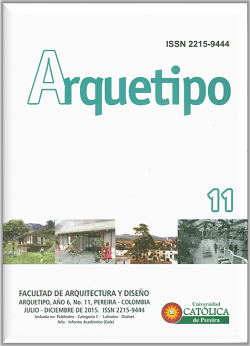Methodological proposal for evaluation of performance facade lighting
Keywords:
Architecture, glare, daylighting, classroomsAbstract
This paper presents a methodology to identify the optimal location and size of differents openings in a façade. The analysis was developed based on three variables: the evaluation of glare sensation, the daylight accessibility and solar accessibility. For the analysis was used a simplified model of classroom, facing north and located in the city of Medellín, Colombia (6.25° N, 75.5° W). Following a fractioned facade method the results were obtained through computer simulation in the program Apolux and geometric calculations of solar incidence. These results allowed the characterization of each fraction of the façade and define the type of strategy needed to improve the characteristics of the internal light environment.
References
ABNT (1991). NBR-15215-4 Iluminação natural – Parte 4: Verificação experimental das condições de iluminação interna de edificações – Método de medição. Río de Janeiro: Associação Brasileira de Normas Técnicas.
ABNT (1992). NBR-5413 Iluminância de Interiores. Río de Janeiro: Associação Brasileira de Normas Técnicas.
CIE (2004). Spatial distribution of daylight — CIE standard general sky. Disponible en http:// www.cie.co.at/index_ie.html
Claro, A. (2009). Apolux Programme. Disponible en https://www.labcon.ufsc.br/foton/
Giraldo, N. (2011). Caracterização dos campos visuais das crianças nas salas de aula: identificação dos componentes arquitetônicos de maior participação na caracterização. Disertación de maestría, Florianópolis: Universidade Federal de Santa Catarina.
Heschong Mahone Group (2002). Re-Analysis Report: Daylighting in schools, Additional analysis. USA: Heschong Mahone Group.
Heschong Mahone Group (2003). Windows and Classrooms: A study of student performance and the indoor enviroment. California: California Energy Commission.
Hopkinson, R.G, Petherbridge P. & Longmore, J. (1966). Iluminação Natural. Lisboa: Calouste Gulbenkian.
Iwata, T., Shukuya, M., Somekawa, N. & Kimura, K.(1992). Experimental study on discomfort glare caused by windows: subjective response to glare from a simulated. window. Journal of Architecture, Planning and Environmental Engineering, 432, 21-33.
Inanici, M. & Navvab, M. (2006). The Virtual Lighting Laboratory: Per-pixel Luminance Data Analysis. Leukos: The Illuminating Engineering Society of North America.
Kaftan, E. (2001). The 18th Internacional Conference on passiveand low energy architecture. In: PLEA, Florianópolis. The Cellular Method to design energy efficient shading form to accommodate the dynamic characteristics of climate. Florianópolis: PLEA.
Kaftan, E. & Marsh, A. (2005). International Conference. Passive and Low energy Cooling for the Built environment. In: Proc. PALENC, Santorini, Grecia, Integrating the Cellular Method for Shading Design with a Thermal Simulation. Grecia: Santorini.
Marsh, A. (2003) IBPSA Conference. Computer-Optimised Shading design. Building Simulation 2003. Eighth International IBPSA Conference, Technische Universiteit Eindhoven, Eindhoven, Holanda.
Martau, B. e Scarazzatto, P. S. (2009). Impactos não visuais da iluminação. Editado por ENCAC X. Encontro Nacional de Conforto no Ambiente Construido. Natal.
Ne’eman, E. (1974). Visual aspects of sunlight in buildings. Lighting, Research And Technology, 6(3), 159-164.
NTC-4595 (1999). NTC-4595 Ingenieria Civil y Arquitectura. Planeamiento y Diseño de Instalaciones y Ambientes Escolares. Bogotá: Autor.
Roberts, A. & Marsh, A.J. (2001). ECAADE In: Proc. of 19th Education for Computer Aided Architectural Design in Europe, Helsinki, 2001. ECOTECT: Environmental Prediction in Architectural Evaluation. 19th ECAADE, Helsinki, Finlandia.
Tuaycharoen, N. & Tregenza, P. (2005). Discomfort glare from interesting images. Lighting, Research and Technology. doi: 10.1191/1365782805li147oa

